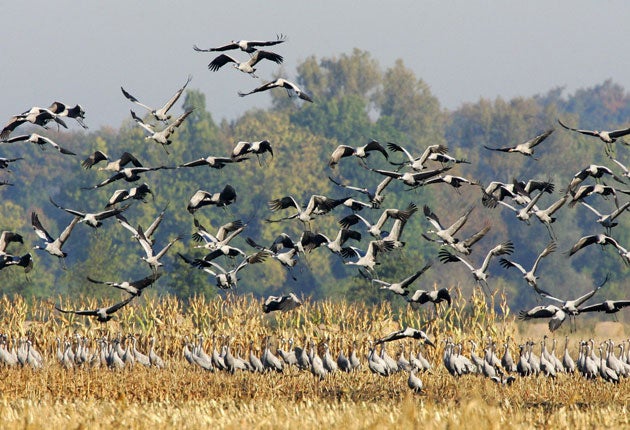Birds capitalise on collapse of Communism

Your support helps us to tell the story
From reproductive rights to climate change to Big Tech, The Independent is on the ground when the story is developing. Whether it's investigating the financials of Elon Musk's pro-Trump PAC or producing our latest documentary, 'The A Word', which shines a light on the American women fighting for reproductive rights, we know how important it is to parse out the facts from the messaging.
At such a critical moment in US history, we need reporters on the ground. Your donation allows us to keep sending journalists to speak to both sides of the story.
The Independent is trusted by Americans across the entire political spectrum. And unlike many other quality news outlets, we choose not to lock Americans out of our reporting and analysis with paywalls. We believe quality journalism should be available to everyone, paid for by those who can afford it.
Your support makes all the difference.The white-tailed eagle floated effortlessly, on wings spanning more than 8ft, above the deserted woods and fields of what was once a state-run Communist collective farm. The enormous raptor, known in Britain as "the flying barn door", is the most visible evidence of a remarkable ornithological success story that has occurred in eastern Germany after the collapse of Communism more than two decades ago.
Since then, nearly two million of the east's 18 million inhabitants have left in search of better employment opportunities in the west. Into this vacuum have come birds. A survey published on behalf of Germany's official Atlas of Breeding Birds has shown that the former Communist east attracted almost twice as many breeding species as those found in western Germany each year. The types of birds found in the east in large numbers included species that have either disappeared from the west completely or are threatened with extinction: cranes, black storks, greenish warblers, great bustards and lesser spotted eagles.
In the east of Germany, the number of breeding white-tailed eagle pairs has increased from 185 in 1990 to 575 pairs. By 1993 the increase in breeding rates meant that the birds could be taken off the endangered species list. And the destruction of the former Communist state's collective farms after reunification led to a fifth of its farmland being left fallow. The untilled fields rapidly turned into nature reserves of their own – oases where wild flowers, grasses and weeds grow with abandon. They in turn attract insects, small field mammals and, perhaps most strikingly, birds. Ulf Bähker, a field guide for Germany's NABU nature conservancy trust who showed The Independent on Sunday the well-populated skies above Mecklenburg, said: "As soon as these bits of land were left to themselves, we saw big increases in small birds like winchats and corn buntings."
But eastern Germany is also blessed with its own wild and largely unpopulated regions that were natural bird sanctuaries well before Communism's collapse. One of the most important is the Oder river delta, which forms the border between Poland and Germany. It covers 25,000 acres and attracts more than two-thirds of the world's population of migrating bean goose each year. The boggy marshland surrounding the river was formally turned into one of Europe's largest nature reserves in 1995 and now acts as a breeding ground for rare species.
Germany's nature conservancy organisations have been acquiring vacant, formerly state-owned areas and slowly turning them into new nature reserves. Some, such as Griever Holz, 500 acres of woodland and grass meadow in Mecklenburg, are home to some of the rarest of east Germany's bird species, including the lesser spotted eagle.
More than 200 years ago, the birds bred all over Germany and other parts of western Europe. But they were routinely hunted down and shot, and by the end of the 19th century they had become virtually extinct in the west. Today, the majority are to be found in eastern Europe, where they arrive in the spring to breed after completing a 10,000km migratory flight from their wintering grounds in southern and eastern Africa.
The birds need a varied and near pristine natural environment; they require wetlands surrounded by woods and grass meadows to find their food, which consists mainly of voles, field mice, frogs and small birds. As a result the lesser spotted eagle finds itself at the top of nature's pyramid in eastern Germany. "If the birds breed successfully, we know we are doing the right things," Mr Bähker said.
Join our commenting forum
Join thought-provoking conversations, follow other Independent readers and see their replies
Comments